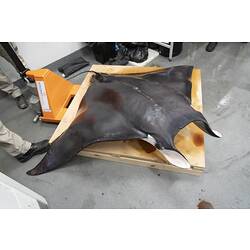General Description
Body is flattened broad and short. The head is very short with the front margin not deeply concave. The anterior profile of body wings is straight or slightly convex. The tail is very long, wiry and whip-like, about equal to or longer than the overall width of the ray (if undamaged), with a stinging spine in most individuals. The mouth is broad, on the underside of the head near the front margin. The upper and lower tooth bands extend around three quarters of the mouth width. Dense tooth-like scales and brachial filter plates are separate on gill arches. There are 85-95 plates per arch and 18-31 lobes on each plate, the terminal lobe being leaf-shaped with longitudinal ridges. The dorsal fin is small with a rounded white tip and a concave rear margin. There is usually a short, serrated caudal spine covered in black tissue behind dorsal fin. Overall width up to 310 cm in males, 240 cm in females and 85 cm at birth. Adult weight around 115 kg.
Biology
Male Japanese Devilrays mature when they reach an overall width of 200-220 cm and females mature at 215-240 cm. In females maturity is estimated to occur at 5-6 years or age and maximum age is estimated to be 20 years. Embryos develop for 12 months, taking their nourishment from yolk and directly from their mother (a system called aplacental matrotrophy). Usually one pup is produced, though occasionally a litter of two may occur. Pups are usually 90-160 cm at bith. The reproductive cycle is 1-3 years, with resting periods between pregnancies in some years.
Japanese Devilrays are filter feeders, mostly feeding on planktonic crustaceans such as krill, euphasids and copepods, along with small fishes.
Mobulids are widely used for their meat, skin, liver oil, and gill plates and are both targeted by fisheries and form bycatch of many small- and large-scale fisheries across their range.
Distribution
Circumglobal in warm coastal and offshore waters. In Australia from Fraser Island, Queensland to off Montague Island New South Wales. A juvenile was found near the shore at Brighton in Port Phillip, Victoria in April 2020.
Habitat
Pelagic in warm coastal and offshore waters, usually above 50 m depth but known to 1,112 m.
More Information
-
Animal Type
-
Animal SubType
-
Brief Id
A large bluish-black devilray having a white underside often with dark patches, a prominent white tip on the dorsal fin, and the inside of the mouth dark. Juveniles have two white crescent-shaped patches on the shoulders.
-
Colours
Blue-black, White
-
Maximum Size
310 cm
-
Habitats
-
Diet
Organic matter
-
Diet Categories
Crustaceans, Krill, Fishes
-
Hazards
Venomous spine on tail.
-
Endemicity
-
Commercial
Yes
-
Conservation Statuses
CITES: Trade restrictions (Appendix II), FFG Threatened List: Not listed, EPBC Act 1999: Not listed, IUCN Red List: Endangered
-
Depths
Shallow (1-30 m), Deep ( > 30 m)
-
Water Column Locations
Midwater
-
Taxon Name
-
Scientific Author
(Bonnaterre, 1788)
-
Common Name
Japanese Devilray
-
Kingdom
-
Phylum
-
Subphylum
-
Superclass
-
Class
-
Subclass
-
Superorder
-
Order
-
Family
-
Genus
-
Species Name
mobular


